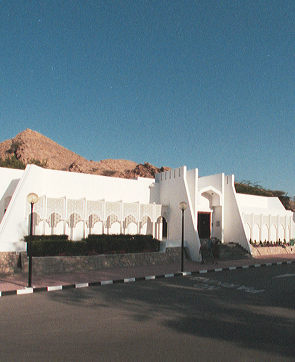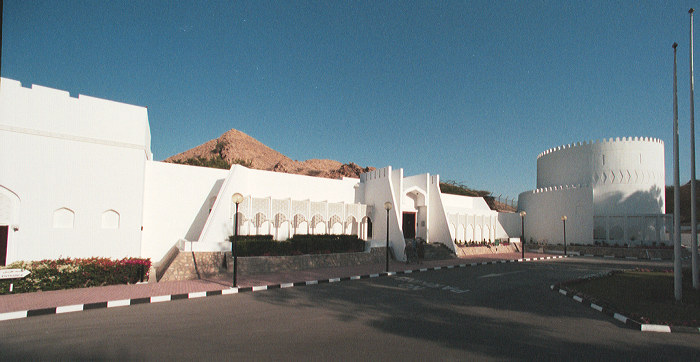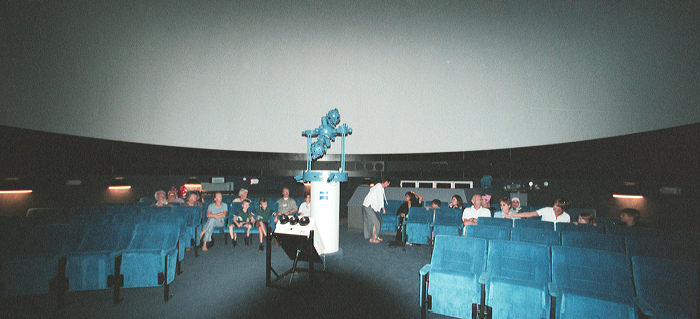
A Brief History
of PDO's New Planetarium
I thought it might be amusing to tell the tale of how PDO (Petroleum Development Oman, the company that produces 90% of the country's oil) came to build and operate a planetarium. Also how the exterior came to look the way it does. Here goes...
Every five years the country celebrates, in a rather grand manner, the 1970 accession to the throne by His Majesty Sultan Qaboos. There is a celebration and public holidays annually of course, but every fifth year is something very special. The year 2000 was His Majesty's 30th anniversary. On an earlier one of these five-yearly occasions (Nov 1979) PDO had built a small Oil Exhibition Centre, containing an exhibits room and an auditorium:

The years rolled on and for 1990 the PDO Management Team solicited ideas for another commemorative project. I proposed a public library. What I had in mind was a fully functional lending library, something that would be useful to many youngsters in the Muscat area. Anyway I proceeded on leave and by the time I came back what the rest of the Management Team had approved was a Public Technical (Reference) Library. Perhaps it was an attempt to control expenditure. Anyway others ran the project and did a splendid job of it. And a lot of school kids do use it, especially in the period just before major exams. The years rolled onto the next solicitation of ideas for a 1995 commemorative project. This time my proposal was for a cable car (teleferique) up the steep side of Jabal Shams (from the Wadi Bani Auf side). I am afraid there were no takers amongst my Management colleagues and what was decided on was a major expansion of the Oil Exhibition Centre. Pity, you still do not have any teleferique going up Jabal Shams (one day in the far future perhaps...). It would have been a spectacular ride! A good 1000 to 1500m vertical rise. Better than the old one at Caracas, Venezuela. Anyway by this time my portfolio of responsibilities had expanded to include more than just oil field facilities and the new Exhibition expansion project landed in my lap. We got a consultant (Cansult) to design us an exhibits hall, with a nice Omani exterior. We then took the sketches to the Minister of Petroleum and Minerals (H.E. Said Ahmed Shanfary at the time) and he suggested we add a tower somewhere so that it looks even more Omani. By this time of course we were running out of time. I called in the architect and told him to stick a tower on one side and, to make sure it looked nice and Omani, I told him to copy the fort at Buraimi, crenellations, diamond shapes in the masonry, etc. Buraimi is far enough away from Muscat that most people would not recognize it immediately :-) He said he knew of it from some guide book and did a great job, new exhibits hall to the left of the pre-existing building, with the rather magnificent tower at one end:

But us
engineer/scientist types had no clue about designing and setting up
modern, inter-active, educational exhibits. So it was decided to run a
competition for the best design proposal to a fixed cost. We got international
exhibits designers to propose a package that, inclusive of the civil works
to extend the building, came up to a fixed sum that matched our budget.
The building design was by then frozen, tower and all; and they just had
to find an Omani partner company to build it for a sum agreed between
themselves. Any money they could save by negotiating a good deal from
their civil construction partner was available to the lead partner
for more or nicer exhibits (or extra profit for that matter). We were
presented with 3 or 4 very different designs for exhibits, all
excellent. Incidentally, one proposal was to put one of those space
journey simulators in the tower, but instead of going up into space it would
descend into the bowels of the Earth and tell a geological tale. Unfortunately
such a fancy exhibit did not leave much money for the rest of the exhibition
space. The PDO Management Team intently listened to all the different
presentations, trying very much to look wise and intelligent, and
chose one. We ended up with a modern, up to date, interactive Oil &
Gas Exhibition Centre, within budget. The interior of the old building was
refurbished at the same time and with my usual pestering of the hapless
project engineers and architects we ended up with an interior having a
nice, Arabic theme, complete with a pyramid skylight over the entrance lobby,
which used to be an open courtyard in the original building. What, you have
never noticed the pyramid skylight? Look up the next time you enter the place,
and bathe in the luminance of that pyramid power. The architects actually wanted
to stick a plain ceiling there... But the years kept rolling.
By 1998 I had reawakened to astronomy, which had been a
hobby during my teenage years. Now, those of you astronerds who subscribe to the
magazine "Sky & Telescope" can't help but notice all those full-page
advertisements for planetarea by the Japanese company Goto Optical.
Consequently it struck me that it would be nice for PDO to build a
planetarium for the 30th anniversary of His Majesty's reign, in 2000. But of
course I had no clue as to costs. Many millions? So I zapped off numerous
e-mails to Goto. The smallest useful planetarium I could think of had to seat at
least a typical classroom, 30 to 40 kids. It turns out that one can indeed build
such a small planetarium with a 6 meter diameter dome for less than a million $.
I proposed a planetarium to our Management Team and after a number of ups and
downs the project finally got approved during 1999. Luck had it that the
oil price had by then dropped down below $15/bbl. My pleas for a million
Rials ($2.6 million) went unheeded and I was told to get on and do it for
$1.5 million, including all the civil works :-( In the meantime I
had solicited advice from various sources on the web and during visits
abroad I tried to get further wisdom by dropping into the planetarea in
London, Amsterdam and Montreal. The gents I met with at London and
Montreal were extremely helpful and spent time explaining the pros and cons of
the various options. My visit to Amsterdam had unfortunate timing. They were in
a panic trying to fix something or other between shows. It was on a rare sunny
weekend and the Amsterdam Zoo (where the planetarium is located) was absolutely
packed, with a long queue waiting to get into the planetarium. Nice jolt of
reality about running a facility for the public!
But I
was still very hazy about how one goes about drawing up a detailed
equipment list in a few weeks. Shopping for a planetarium is like entering
a huge, virtual, hi-fi store and picking up a zillion projectors, sound
systems, etc so that you end up with a cohesive whole capable of
simulating everything, including flying to the Moon! Real toy shop affair.
I can well imagine salivating planetarium directors pouring over equipment
catalogues... So, as in the past, when you know not what to do, get the
ones who do know to compete with each other. I zapped off e-mails to Evans
& Sutherland (they make work-station/video based star projectors, as
used in the London Planetarium), Spitz (well known for low cost star
projectors and very popular with US colleges on tight budgets), plus Minolta,
Zeiss, and of course Goto. Seems that the last 3 have a reputation for top
notch star projectors, at a price. In the meantime I had learnt that we
could not use a simple concrete dome, like in a mosque, because the sound
reverberations would muddle up all the commentary and music. I had thought
that since Omani contractors certainly have a lot of experience in
building mosque domes, we could save quite a bit by using a simple coat of
paint instead of purchasing a special aluminium, perforated dome screen.
No go.
We asked all five bidders to
submit packaged proposals inclusive of dome screen, chairs, sound
system, click and play programs, whatever, for a fixed price of $1 million. I
reserved $400,000 for the building to accommodate a 6-meter dome and secretly
hoped to squeeze in a small, off-site observatory with a 16" Mead LX200
telescope scope using the remaining $50 to $100,000. One bidder could not submit
a package at $1 million, asking for a minimum of $1.3 million. Tough titty! Two
others insisted we go the toy store route by offering a starter pack at around
$700,000 and flooding us with catalogues for the rest. We had neither the
competency nor the time for a toy store approach. The last two gave us
very detailed proposals priced at exactly $1 million. One offered an
11-meter dome, capable of seating 60. By then I had learnt from a college
in the Carolinas (thanks to the www and e-mail) that the magic
number to aim for was 60, because that's the seating capacity of
most coaches. Zeiss won the tender with their 11-meter dome, 60-seat
proposal. Included were three click and play half hour programs,
each in English and Arabic, one program for kids, two for adults. We
also signed them up for a multi-year maintenance contract that would bring
us a new program annually. As for the building itself; well, I called in
Cansult, who had done the previous architectural design (with the Buraimi
tower) and told them to stick in another tower with concentric utility
corridors and plant rooms on the outer rim. Came out great! But since we
ended up with an 11m rather than a 6m dome, there wasn't enough money left over
for an observatory :-( The planetarium is in the round tower on the
far right:

The original small Oil Exhibition
Centre has thus by now grown into a nice, sprawling edifice:
At the time of
writing (March 2001) the Planetarium has public shows of a program describing
the search for extra-solar planets. Actually, for such a small facility,
Zeiss has done an excellent job of equipping it. The public are
entertained with a laser show at the start, complete with a steam generator to
make the light patterns stand out. There are even horizon projectors (see a 360
horizon view of Mars, courtesy of NASA), a Barco video projector,
projectors for planets, Milky Way, Gegenschein(!), etc, etc. And a decent
sound system. Great stuff! And the public gets to see it all for free. Shows are
in either English or Arabic and if you are in Muscat just phone 24675542 to
reserve your seats. Or visit PDO's
website to check out the
timings. Weekday mornings are for school groups and I am told that a few
thousand kids have already been through it. I hope the original intent that the
kids coming to the Planetarium also take time to visit the Oil & Gas
Exhibition next door actually happens... We wanted to sell them the idea that a
career in Oil & Gas can be an exciting, high-tech thing. By the end of 1999
we had set up a Planetarium Committee that included the Chairman and the
Secretary of the Astronomy Section of the Ras al Hamra Recreation Centre (PDO
staff club) to come up with illuminated panel exhibits for the corridors
and to have a supervisory oversight on the proceedings. I retired from PDO at
end 1999 and the Committee did an excellent job of seeing the project to a
successful, on-time completion. The Planetarium opened to the public, on
schedule, early November 2000. Here is what the interior looks like:

Nice facility, if you are in Muscat
you should make sure you take in a show.
For more stuff return to Samir's Home
To drop me an e-mail just
click on:
samirkharusi